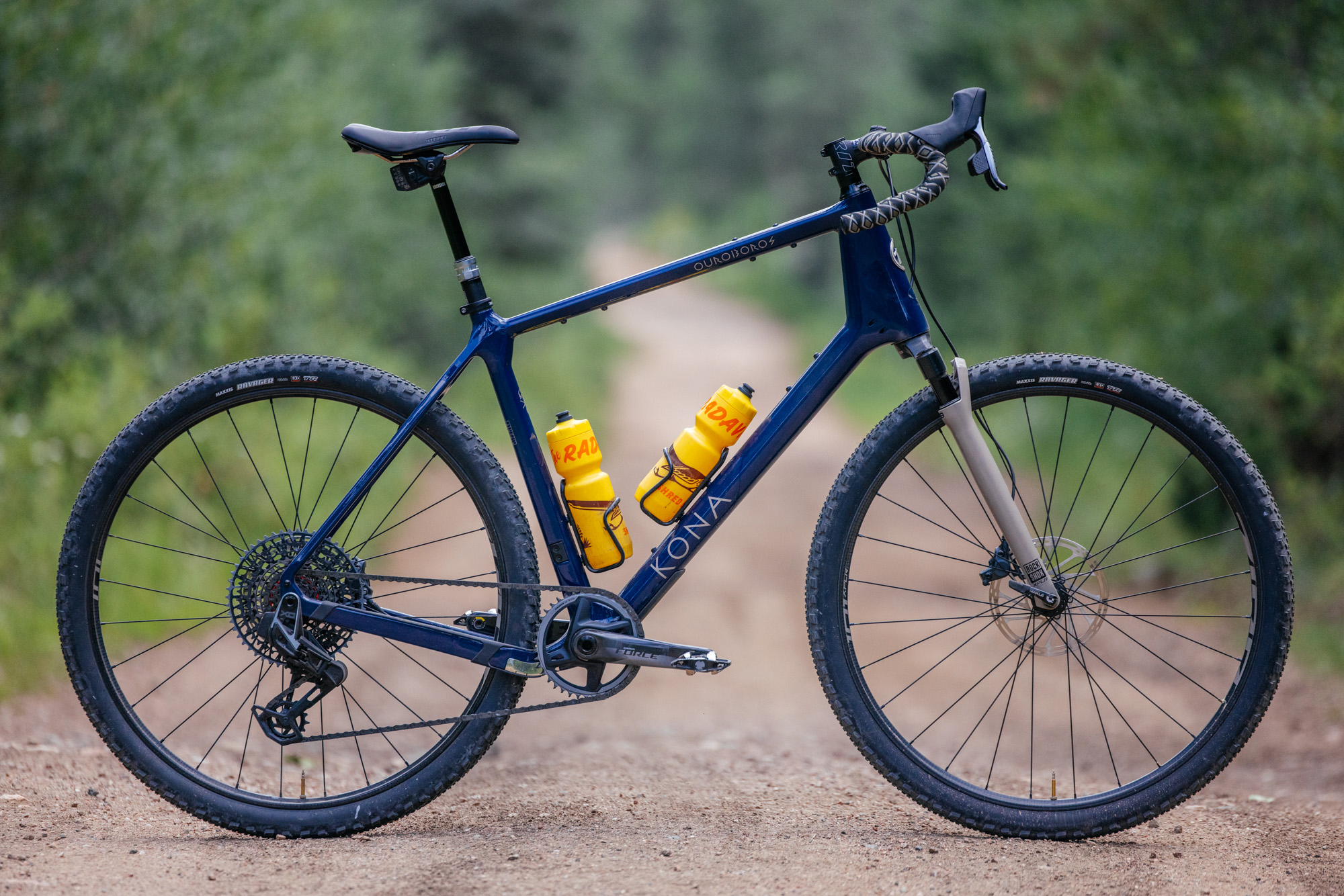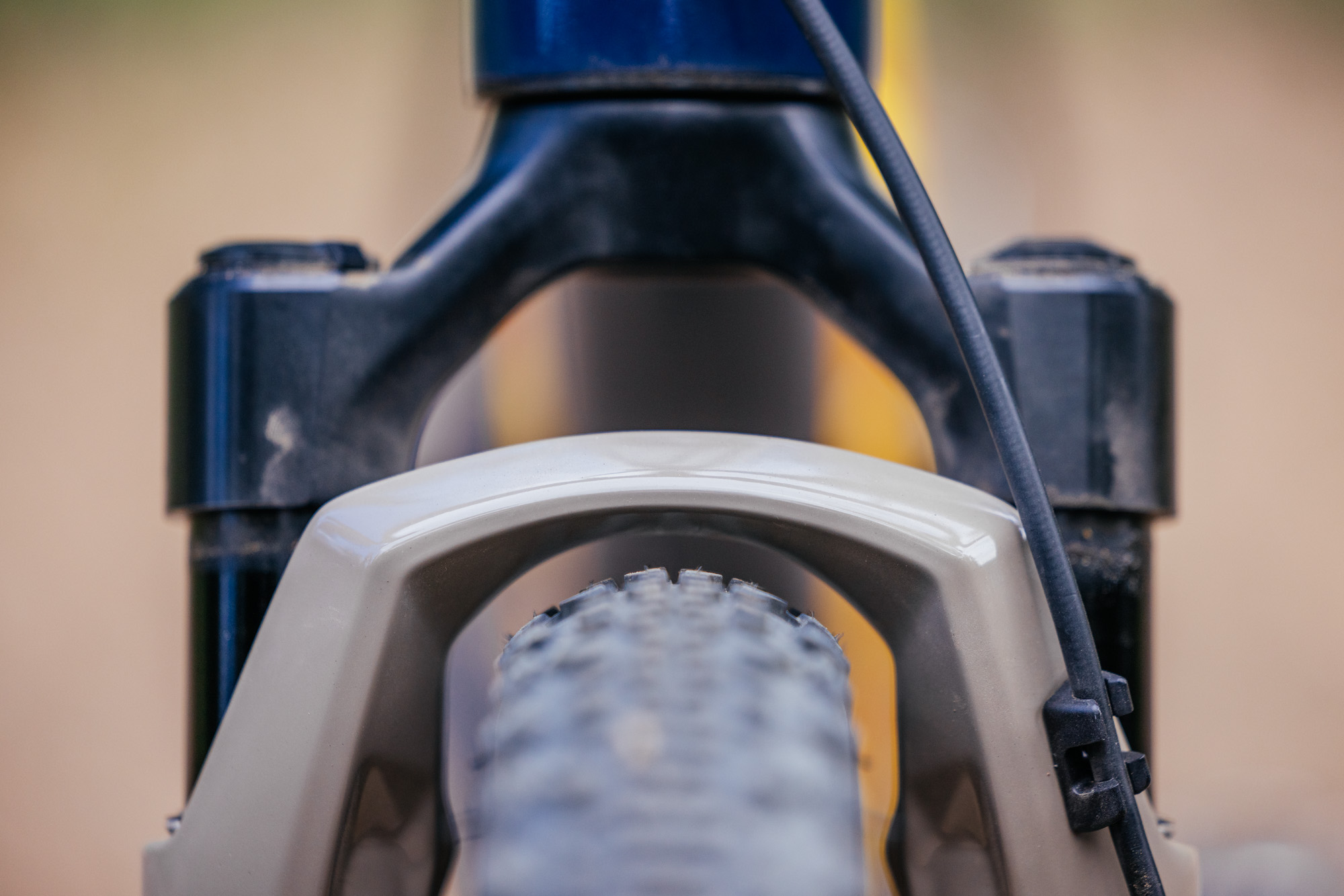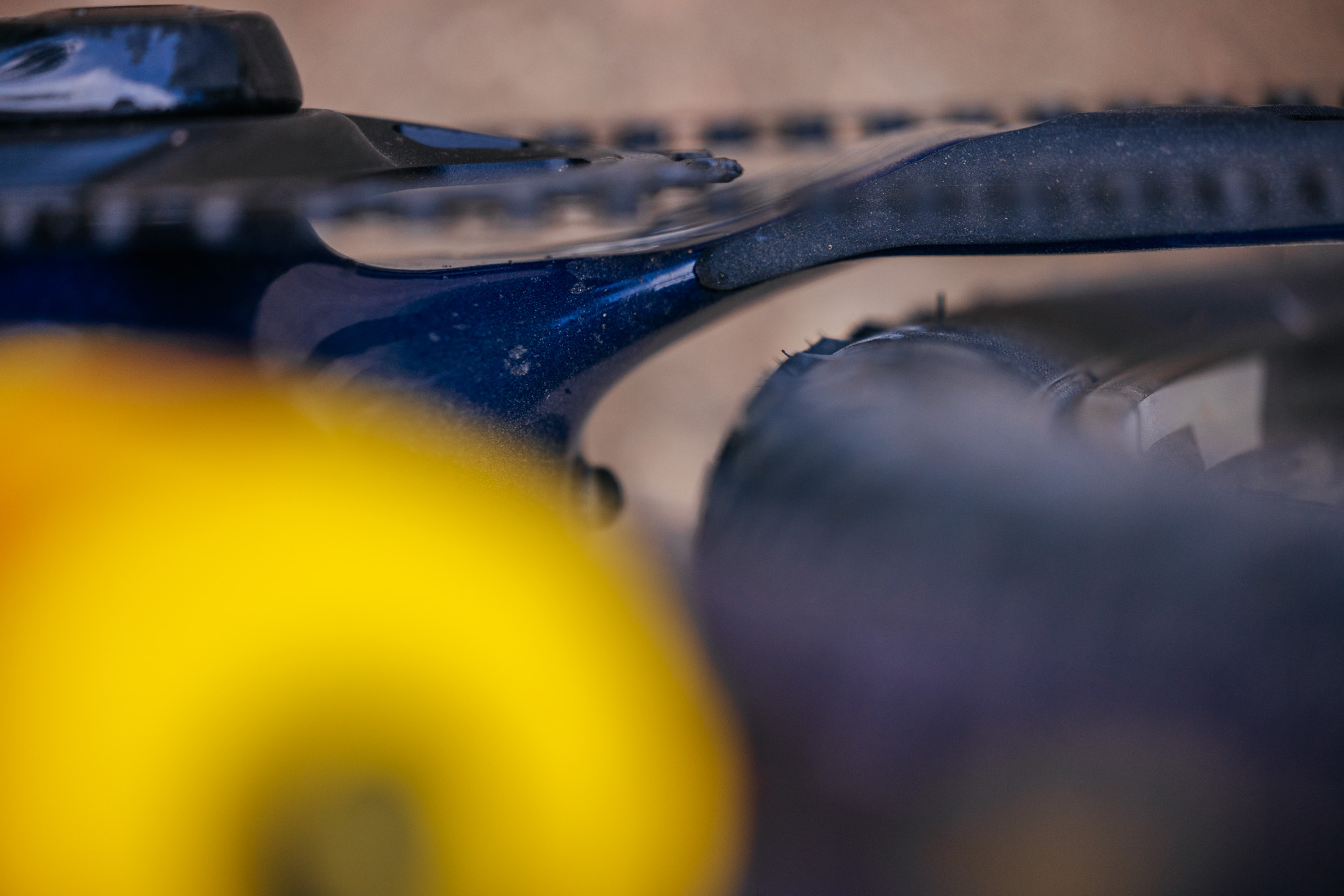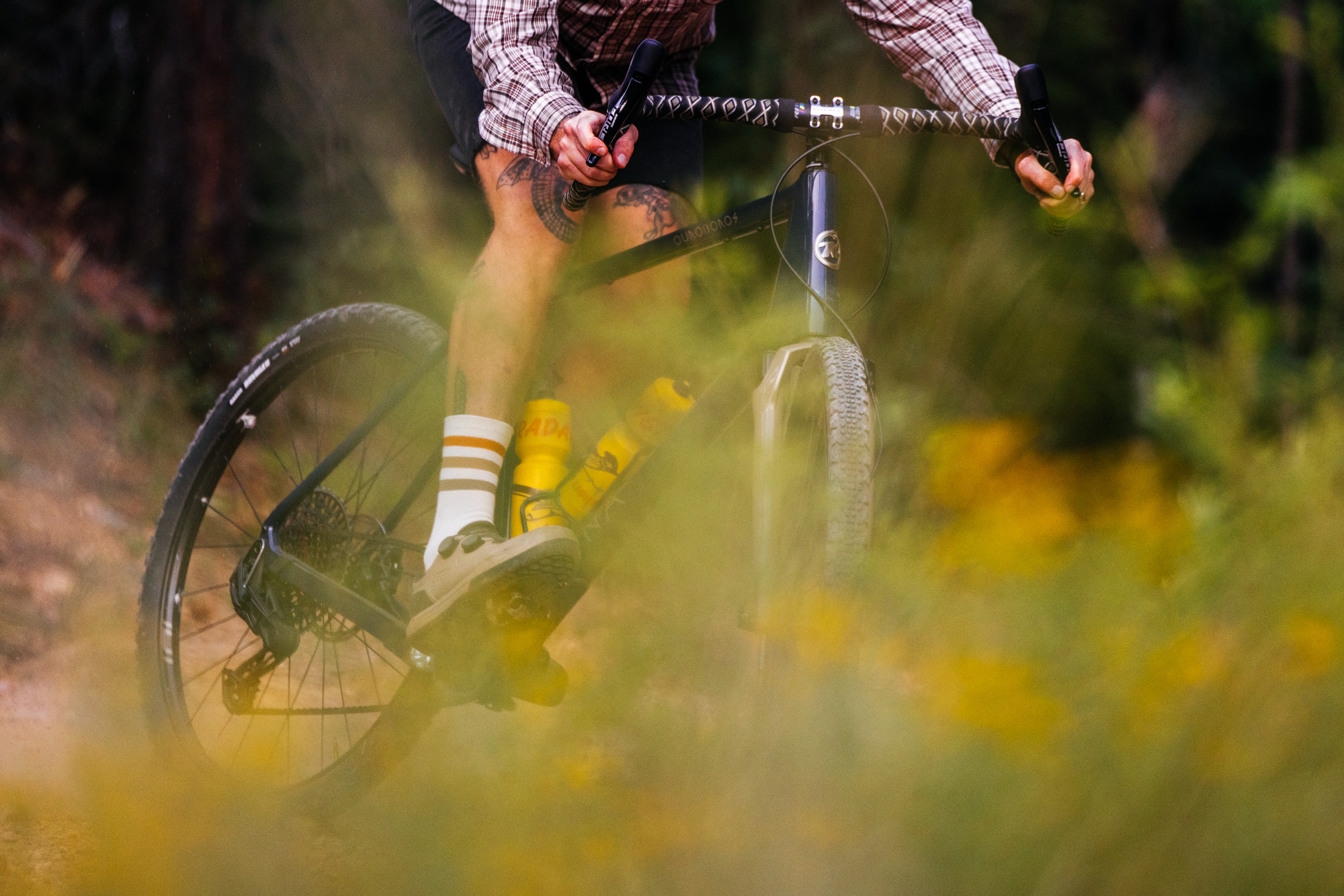Since posting our first look back in April, John’s been putting in miles on the Kona Ouroboros Supreme and finally wrapped his head around not only how to classify this bike but also what its best use case is. Is this the next stage in the evolution of gravel bikes?

Kona Ouroboros Supreme Quick Hits
- 48, 50, 52, 54, 56, 58 cm sizing
- 58 cm reviewed here
- Three total build kits:
- Ouroboros Supreme (reviewed here) USD $6999
- Ouroboros CR DL USD $3499
- Ouroboros CR USD $2799
- RockShox Rudy 40 mm travel in Supreme build spec
- 5 mounting points on frame (limited to front triangle)
- Fender mounts (not rack mounts) on the rear
- 142 mm rear spacing
- Road chainline
- 50 mm tire clearance (safe, 53 mm MAX)
- 31.6 mm dropper post (rejoice!)

Sacred Geometry
The geometry is straightforward with a constant 69.5º head angle (unsagged) across all sizes, a variable seat tube angle, and the Ouroboros bottom bracket drop is split between the three smaller sizes and three larger sizes. As a 6’2″, 190 lb human with long legs, I reviewed the largest size, 58, and the reach perfectly matched the stack at 405 mm and 660 mm, respectively.


What is Gravel?
I often use taxonomy to categorize the phenotype of bicycles whose appearance is altered by demand or terrain. Like how architectural “styles” are merely products of the building’s environment – from storm shutters, adobe construction, hurricane stars, and low-lying, overhanging rooflines in desert architecture – bikes evolve over time to reflect the terrain they are ridden on.

Jobst, Tom and crew, Portola, Photo: Ray Hosler, via Ritchey Logic
As gravel went from weirdos underbiking on ‘cross bikes or legends like Jobst Brandt tackling rough terrain on 28 mm tires to road racing 2.0, people might be left confused and asking, “What is gravel?”
I bring this up because I feel like it’s not discussed enough in bike media. In doing so, I’m hinting at a two-part issue. Modern gravel bikes, as accepted by the masses, are just road bikes with fatter tires, and modern gravel bikes made by large corporations in the bike industry are, by and large, gravel racing bikes in terms of fit, particularly stack height.
Meanwhile, I would argue that a majority of people riding gravel bikes are probably not racing. Leading to…

What Gravel Ought to Be
Miguel and I chatted about this during our Town to Towers video. Gravel is subjective. It’s a vernacular. What defines gravel is based on what your local gravel looks like. In some places, hardpack dirt roads with rolling hills are gravel. As such, a gravel road bike fits the bill. In other locales, gravel can include steep and long rough and rocky climbs with techy descents. In those places, I think a gravel bike ought to be defined differently.

New Mexico “gravel”
Think of the famous gravel in the Flint Hills or the Driftless Region as those locales define gravel versus what we have here in the Southern Rockies: sustained, steep climbing through very rocky terrain. I think bikes with taller stack numbers are what gravel bikes ought to be, and these bikes differ drastically from gravel racing bikes.



Cotic Escapade (gravel road), left, Ouroboros (adventure gravel?) middle, Tumbleweed Stargazer (drop-bar mountain bike) right.
Taxonomy: What is the Ouroboros?
In the same ways I jokingly picked on the Hudski Doggler for being a mashup of a mountain bike and a gravel bike, the Ouroboros is the drop-bar version of that evolutionary meddling. The Doggler is the flat-bar mutation, and the Ouroboros is the drop-bar deviation.
A gravel road bike and a mountain bike had a love child, and the dominant and recessive genes played a game of back alley craps to determine what this offspring would look like. The rear end of the bike is non-boost, the crank chain line is road, the tire size is limited to 50 mm, which is a gravel tire size, but the stack is high, you run a short stem, and it has a compact triangle with a sloping top tube like a mountain bike. The build kit I reviewed comes specced with a cute widdle suspension fowk.

Yet, it is not a drop-bar mountain bike because it is not a modern mountain bike. For a bike to be a modern mountain bike, I believe it needs to meet two criteria:
- 148 mm boost rear hub spacing
- > 2.2″ tire clearance
Keep in mind, this only applies to modern bikes, as in bikes currently offered new today. The simplest breakdown is: if a bike has 148 mm MTB boost spacing and a MTB chain line/crankset, it’s a mountain bike. If it has 142 mm road/gravel spacing and a road chain line/crankset, it’s a road/gravel bike at its core.

My 2012 Bruce Gordon Monster Cross overlaid on top of the 2024 Kona Ouroboros reveals they are close relatives on the bicycle taxonomy family tree.
Following this logic, the Ouroboros, to me, is a gravel bike, even though it exhibits some biomimicry of a drop-bar mountain bike. If it had rack mounts, it’d be a gravel touring bike (like the Bombtrack Beyond), and if it had boost spacing and MTB tires, it’d be a drop-bar 29er mountain bike (Like the Tumbleweed Stargazer). Instead, it’s a gravel bike, not a gravel road racing bike, but a gravel bike or, as some people call bikes like this, an adventure gravel bike.
Check out our post on drop-bar 29er mountain bike taxonomy for a deep dive into this topic!

Riding Rebirth
Much like the ancient Mesopotamian symbol of the ouroboros represents, my opinions on this bike went through a rebirth cycle.
It’s no secret that when I moved from Los Angeles (the gravel heaven of the USA) to Santa Fe (an arguably mountain bike mecca of the Southern Rockies) there was an abrupt uptick in mountain bike reviews. Flat-bar mountain bikes began to get posted here in higher frequency: rigid, hardtail, and full suspension. As a byproduct of my home terrain, I fell in love with riding and bike camping on drop-bar mountain bikes.
It’s because the terrain here varies, and on almost every ride, I’ll hit singletrack, so a bike with a wide gear range and big, fat tires is favored for one reason or another. This is why I’ve lauded the Tumbleweed Stargazer and Singular Gryphon. They are the perfect drop-bar mountain bikes for my home terrain.

Ride Quality
Looking at those big, beefy head tube gussets and a thick down tube, you’d think the Ouroboros would be a super stiff bike. Yet, through the comparatively slim seat stays and shaped top tube, it actually flexes quite nicely under pedaling load. Sure, the fork helps soften the ride quality considerably, but suspension isn’t utilized on bikes for that alone; it’s implemented for an increase in traction.



In an attempt to show how much the Rudy helps maintain traction, here are three photos: Note how the front fork keeps the front wheel on the ground, rolling over the rock, while the rear wheel bounces off on impact. This is suspension at work… even 40 mm of travel keeps the wheel on the ground.
Through the 40 mm of up and down travel supplied by the Rudy, the Ouroboros (in the Supreme parts spec) keeps the front wheel planted while climbing through chunderous terrain. It helps maintain contact while descending down washboard and rutted corners. We’ve had a lot of rain this year in Santa Fe, and all of our dirt roads are in rough shape. Having some extra traction on the front end gives the Ouroboros a planted and calm demeanor.

Some bikes, like road bikes and gravel racing bikes, ride with the sensation of your weight being high and over the front end. Other bikes, like long travel full suspension bikes, feel lower and are more rear-weighted. Bikes like the Ouroboros are incredibly neutral, resulting in a sensation of riding “in” the frame rather than atop it.
The resulting control feels more balanced and predictable since your weight remains fairly neutral both while climbing and descending.

Descending on fire roads like the above photo is completely comfortable in the drops on the Ouroboros but riding singletrack, not so much.
I’ve got a few notes expanding on the body position during the ride experience. I found that the Ouroboros likes to be ridden on the hoods most of the time like a gravel bike, and drop-bar mountain bikes like the Tumbleweed Stargazer are designed to be ridden in the drops. The Stargazer is also very comfortable in the drops on singletrack, the Ouroboros to me is not, I have to ride on the hoods. The two bikes have very similar geometry but the Stargazer has 2 cm more stack, which adds up in terms of comfort while descending. Rather, the Ouroboros feels very much like a gravel bike during the descents.

Positives: The Serpent’s Head
The catalyst for rebirth in the ouroboros symbol is the head. It devours the old, dying body in a constant cycle of regeneration.
The Ouroboros is ultra-light. The size 58 cm – the largest size available – I’ve been riding tips the scales at 24 lbs and all but disappears on tired legs while taking on big climbs like our Town to Towers ride. The bike’s tall stack makes it comfortable to “rest into” a sustainable riding position while descending in the drops puts you in a controlling stance without hunching over.

Its front triangle is massive if you’d want to take it out on a big, all-day ride with a stuffed frame bag, and the bike looks perfect with big, wide drops. There are tons of mounts for cargo cages, extra bottles, or bolt-on bags for longer rides, and the compact triangle makes for plenty of room for rowdy descents.


Thank god there’s a 31.6 mm dropper post! Why limit the seat post travel with 27.2 mm diameter posts? Good on ya, Kona!
I like that the bike is polarizing and kooky-looking. Cunningham’s 1978 CC Proto was the first drop-bar mountain bike in modern times, and it’s still a strange-looking creation. Even today, dirt drop bikes from the 1980s look super funky, but they ride so damn well. Some might even say the ride quality is superior to flat bars, as Mike Varley pointed out in his Dropping In article I shared earlier this month.
One last note: bike branding is hit or miss with me these days, but I really enjoyed the Ouroboros’ insignia.

Critiques: The Serpent’s Tail
…And the tail represents lessons learned through past experiences in the ouroboros symbol. Rebirth is continuous.
It took a while for me to figure out what the Ouroboros’ intended use case was. I think there’s a lot of potential in the platform for Kona in the future as it could be the ultralight kin to the Sutra LTD and a Salsa Cutthroat competitor. As it sits now, it’s more in line with a gravel adventure bike than a proper drop-bar MTB, which bugs me.
A big caveat ahead:
If you have no interest in the Ouroboros being a drop-bar MTB, you can skip this section. This is not a critique of what the Ouroboros is in its current form, but rather what I’d like it to be. If you’re ok with it being a gravel bike, skip to the TL;DR!

If you’re curious how I’d give the Ouroboros a remodel, well, here ya go:
First, open the rear end up. 142 mm spacing denotes a non-mountain bike chassis. For a modern bike, which the Ouroboos is, 142 mm spacing is for gravel and road wheels. If it is to compete with others in the space like the Salsa Cutthroat or Esker Lorax, give it mountain spacing and yes, bigger tires with a mountain bike crank and chainline. The 50 mm tires just don’t cut it for proper drop-bar mountain bike terrain, either. You can always put smaller tires on if you just want to ride gravel roads.
This brings me to the main issue I have with the Ouroboros; both it and the Sutra LTD need to be boost-spaced bikes to be legit drop-bar mountain bikes. Kona is a mountain bike brand, so why not use mountain bike spacing on the Sutra LTD and Ouroboros?
Not to mention, MTB wheels are stronger by nature of the hub shell flange spacing, so why not embrace that? Why put the wheels from a gravel racing bike on an all-terrain machine like this? This would also eliminate the flat-mount brakes, which I’m not a fan of.


Second, the fork. Ditch the widdle Rudy (1300 g) and go with an 80 mm travel RockShox Recon Gold (1805 g) or the feather light 1276 g Fox 32 Step Cast; those forks rule! Why limit the chainstay tire clearance because the fork in the Supreme build spec only fits a 50 mm tire? The Recon clears a 2.8″ tire! I felt like the marketing of the Ouroboros is misleading on Kona’s site as it states: “run a 29 x 2.5 front tire with the carbon rigid fork…” but the frame does not clear a 2.5″. At most, I tried squeezing in a small-knobbed 2.1″ tire, and its natural wobble rubbed the chainstays.
In all honesty, the reason the bike is so polarizing is that the proportions of the head tube don’t align with the fork’s travel and tire size, especially on the 58 cm bike I reviewed. I’d much rather see an 80 or 100 mm fork and up to 2.6″ tires on this bike, front and rear, than the 40 mm Rudy fork and 50 mm tires. It just looks off.


By increasing the fork’s axle to crown and allowing for 80 – 100 mm of travel on a cross-country fork, the head tube of the Ouroboros could shrink, and it wouldn’t look so obtuse in size 58 cm due to the massive head tube gusset. To be completely honest, when I first received the bike, I thought it had some sort of steering stabilizer encapsulated in it.
At the smaller end of the sizing spectrum, it looks fine, but in the size 58 cm I reviewed, it looked like someone allowed a FEA model to dictate the design of a bicycle. While there’s no harm in allowing 3D analysis models to inform design, they ought to not solely be the deciding factor in design. That’s the form-driven architect in me talking but it looks like an engineer’s FEA model “designed” this bike.
As I said, this is only an aesthetic issue on the largest size Ouroboros, so take it with a grain.

Third, Kona calls this a bike for “multi-day bikepacking” and in the Supreme build spec, I question that assertion. It could be a bike for touring or camping with some engineering. Right now, with no rack mounts and by speccing the AXS dropper, running a saddle pack is out of the question since the AXS battery interferes with bikepacking saddle packs.
Clamping a rack to the seat stays as some rack system use would theoretically work. Still, Kona’s engineers said they couldn’t approve of that method because the ultralight thin seat stays on this very lightweight bike. The only option that Kona approved in an email is a Tailfin-style rack that mounts to the UDH axle and attaches to the seat collar. The brand says they ISO test that junction:
“This area is much stronger, there’s an ISO vertical fatigue test that pushes down on the saddle, loading the ST.”
This third point always bugs me. I can see why Kona calls this a “multi-day bikepacking” bike because bikepacking bags do not require racks at all; they simply strap to your handlebars, frame, or saddle rails. By that logic, any bike can be a bike for “multi-day bikepacking.” However, even a bikepacking saddle pack won’t work on the Supreme spec due to the AXS dropper battery interference. Granted, the other two specs of the Ouroboros will work with a bikepacking saddle pack since the CR build has a cable dropper and the CR/DL has a rigid post, but the Supreme spec I reviewed won’t.
Without hammering too hard on the parts spec on the Supreme build kit, I will note that the Salsa Cutthroat AXS build is specced with a cable-actuated dropper for this very reason. Or you could abandon the dropper all together and all its advantages for a bike like this and run a rigid post, I suppose.
This is also coming from someone who would rather take a dedicated touring bike on a multi-day bike camping trip and use racks. It has no bearing whatsoever on my classification of the Ouroboros as an adventure gravel bike.

Fourth, there needs to be a larger size. The 58 cm feels a tad short on me, as a 6’2″, 190 lb human with long legs, so I can’t imagine someone being taller and trying to fit on the 58 cm.
–
With these points, I feel like the Ouroboros will solve its identity crisis and evolve to its true potential. Or perhaps that’s a whole new model for Kona? They could call it the TOURoboros…

TL;DR and the Take-Away
Look, the Ouroboros is a weird and unique bike; hopefully, this review matches its idiosyncrasies. On the one hand, it’s what I truly believe most people ought to be riding for “gravel,” but on the other, it’s not willing to fully commit to being a true drop-bar mountain bike while exhibiting a bit of biomimicry.
Most crucially, it lacks the proper touring accoutrements like rack mounts to be considered a multi-day tourer.
Identity crisis and use case aside, the ride quality is top-notch on a lightweight package that all but disappears on the climbs and commands the descents. With an increase in traction due to the Rudy suspension fork and a piloting position that instills confidence, it’s easy to see what the crew at Kona intended with the Ouroboros. Plus, it’s a really fun bike to rally down a fire road and jump over water bars on!

I’d love to see Kona’s Barry Wicks rally this bike in a gravel race!
The question is, do you agree with this assessment? Is this the bike for your gravel terrain? If so, the Ouroboros might be the perfect bike for you. If you desire something more robust with rack mounts made for the long haul, there are countless other specimens on the market.
I’ll give it to Kona, though; the Ouroboros is a fuckin’ cool and unique bike that impressed me. It left me unsure of how to approach this review. I went back and forth on it for months! Pushing paradigms ain’t easy, nor is writing about them, but it happens with big, bold moves like this that evolve the conversation and gravel zeitgeist.

Pros
- Lightweight
- Proper stack
- 31.6 mm dropper compatible
- Off-road tuned geometry
- Plenty of front triangle bottle or bag bosses
- Great parts spec
- 40 mm suspension
Cons
- Tire size limited by suspension fork (50 mm)
- Supreme spec’s AXS dropper interferes with bikepacking saddle packs
- Head tube gusset in size 58 cm is obtuse
- Could use a larger size than 58 cm
Highly Subjective Cons
- Needs an 80 mm suspension fork
- Non-boost spacing
- Road chain line (this is not a road bike!)
Check out more at Kona!




















































































































